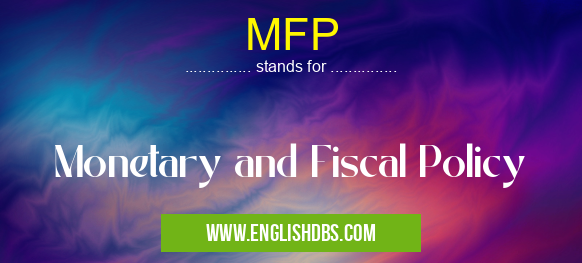What does MFP mean in
Monetary and Fiscal Policy (MFP) plays a critical role in managing an economy. It encompasses the measures adopted by a government to influence the supply of money and the overall level of spending, with the aim of achieving economic stability and growth.

MFP meaning in in Governmental
MFP mostly used in an acronym in Category Governmental that means Monetary and Fiscal Policy
Shorthand: MFP,
Full Form: Monetary and Fiscal Policy
For more information of "Monetary and Fiscal Policy", see the section below.
» Governmental »
MFP Meaning in Governmental
MFP refers to the coordinated efforts of government entities to influence economic activity through monetary and fiscal policies. Monetary policy is primarily handled by central banks, while fiscal policy is implemented by governments.
MFP Full Form
- Monetary Policy: Regulates the money supply, interest rates, and credit availability.
- Fiscal Policy: Influences government spending and taxation to stimulate or dampen economic activity.
What does MFP Stand for?
MFP is an abbreviation used to describe the interconnected approaches of:
- Monetary Policy:
- Adjusting interest rates
- Controlling money supply
- Influencing credit availability
- Fiscal Policy:
- Modifying government spending
- Adjusting tax rates
- Managing budget deficits or surpluses
Essential Questions and Answers on Monetary and Fiscal Policy in "GOVERNMENTAL»ECONOMY"
What is Monetary and Fiscal Policy (MFP)?
Monetary and fiscal policy (MFP) refers to the tools used by central banks and governments to influence the level of economic activity and manage inflation. Monetary policy involves actions taken by central banks to control the money supply and interest rates, while fiscal policy encompasses government spending and taxation decisions.
What are the goals of MFP?
The primary goals of MFP are to:
- Stabilize economic growth and reduce unemployment
- Control inflation
- Maintain financial stability
- Promote long-term economic development
How does monetary policy work?
Monetary policy works by influencing the cost and availability of money in the economy. Central banks adjust interest rates, which affect borrowing and lending activity. Lower interest rates encourage spending and investment, while higher rates discourage them. Central banks also use open market operations and quantitative easing to manage the money supply.
How does fiscal policy work?
Fiscal policy involves government decisions on spending, taxation, and borrowing. Increased government spending or reduced taxes stimulate economic activity, while decreased spending or increased taxes have a contractionary effect. Governments use fiscal policy to influence aggregate demand, manage inflation, and redistribute income.
What is the relationship between monetary and fiscal policy?
Monetary and fiscal policy can be complementary or conflicting. Coordinated policies can enhance their effectiveness. For instance, expansionary monetary policy (lower interest rates) can support expansionary fiscal policy (increased government spending) to stimulate economic growth. However, conflicting policies, such as expansionary monetary policy with contractionary fiscal policy, can offset each other's effects.
What are the challenges of implementing MFP?
Implementing MFP effectively requires careful coordination and timing. Challenges include:
- Lags in the transmission of policy effects
- Uncertainties about economic conditions
- Political constraints and public opinion
- Potential side effects on financial markets and inflation
Final Words: MFP is an essential tool for governments to manage economic fluctuations, promoting economic growth, price stability, and full employment. By skillfully coordinating monetary and fiscal policies, authorities aim to create a stable and prosperous economic environment.
